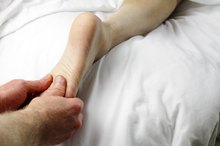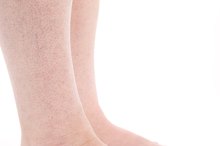How to Tell if You Have a Bruised MCL
Your medial collateral ligament -- or MCL -- is located along the inside of your femur -- thigh bone 1. Your MCL runs down the side of your knee and connects to your tibia -- shin bone. Your MCL functions to prevent your knee from buckling under stress. A bruise to your MCL can occur as the result of a direct blow to the inside of your knee or as the result of an abnormal twisting or movement of your knee. This may also be referred to a contusion.
If you are experiencing serious medical symptoms, seek emergency treatment immediately.
Recall an instance of injury. If you bruised your MCL, you will likely be able to recall when your injury occurred. You may remember following, colliding with another athlete or a sudden, twisting of your knee joint.
Ligament Tear & Knee Hyperextension
Learn More
Take note of the location of your pain. A bruised MCL will cause pain and tenderness along the inside of your knee.
Look for bruising and swelling. A contusion crushes your muscle fibers and connective tissues without causing damage to your skin. Your skin may turn a blue-ish, purple color as the result of blood pooling underneath your skin. Swelling may also occur along the inside of your knee.
Pain in the Knee & Occasional Popping When Walking
Learn More
Visit with your doctor. MCL bruises are usually nothing serious. However, bruises may be an indicator of a more severe injury. Bone fractures, knee dislocations, sprains and ligament damage can also occur to your knee and MCL. If pain from your MCL bruise persists for more than a few days, visit your doctor for a diagnosis.
Tips
MCL bruises can normally be treated at home. Treat using the RICE method. Rest your affected leg. Apply ice for 15 to 30 minutes at a time, three to four times per day. Apply a compression bandage to your knee to control swelling. Elevate your knee as much as possible for the first 48 hours following injury.
Related Articles
References
- SportsInjuryClinic.net: Medial Collateral Ligament MCL Sprain
- American Academy of Orthopaedic Surgeons; Muscle Contusion; July 2007
- Kazemi M, Dabiri Y, Li LP. Recent advances in computational mechanics of the human knee joint. Comput Math Methods Med. 2013;2013:718423. doi:10.1155/2013/718423
- American Academy of Orthopedic Surgeons. (Review March 2014) Collateral Ligament Injuries.
- Grawe B, Schroeder AJ, Kakazu R, Messer MS. Lateral Collateral Ligament Injury About the Knee: Anatomy, Evaluation, and Management. J Am Acad Orthop Surg. 2018;26(6):e120-e127.
- Naqvi U, Sherman Al. Medial Collateral Ligament (MCL) Knee Injuries. [Updated 2019 Jun 4]. In: StatPearls [Internet]. Treasure Island (FL): StatPearls Publishing; 2019 Jan-. Available from: https://www.ncbi.nlm.nih.gov/books/NBK431095/
- Evans J, Nielson Jl. Anterior Cruciate Ligament (ACL) Knee Injuries. [Updated 2019 Mar 8]. In: StatPearls [Internet]. Treasure Island (FL): StatPearls Publishing; 2019 Jan-. Available from: https://www.ncbi.nlm.nih.gov/books/NBK499848/
- Kiapour AM, Murray MM. Basic science of anterior cruciate ligament injury and repair. Bone Joint Res. 2014 Feb; 3(2): 20–31. doi: 10.1302/2046-3758.32.2000241
- American Association of Orthopedic Surgeons. (Reviewed March 2014). Anterior Cruciate Ligament Injuries.
- Blunt CW, Jonas CE. Knee Pain in Adults and Adolescents: The Initial Evaluation. Am Fam Physician. 2018 Nov 1;98(9):576-585.
- Marieswaran M, Jain I, Garg B, Sharma V, Kalyanasundaram D. A Review on Biomechanics of Anterior Cruciate Ligament and Materials for Reconstruction. Appl Bionics Biomech. 2018; 2018: 4657824. doi: 10.1155/2018/4657824
- Pache S, Aman ZS, Kennedy M, et al. Posterior Cruciate Ligament: Current Concepts Review. Arch Bone Jt Surg. 2018;6(1):8–18.
- American Academy of Orthopedic Surgeons. (Review February 2009). Posterior Cruciate Ligament Injuries.
- Johns Hopkins Medicine. (n.d.). Knee Ligament Repair.
- Eitzen I, Moksnes H, Snyder-Mackler L, Risberg MA. A progressive 5-week exercise therapy program leads to significant improvement in knee function early after anterior cruciate ligament injury. J Orthop Sports Phys Ther. 2010;40(11):705–721. doi:10.2519/jospt.2010.3345
Tips
- MCL bruises can normally be treated at home. Treat using the RICE method. Rest your affected leg. Apply ice for 15 to 30 minutes at a time, three to four times per day. Apply a compression bandage to your knee to control swelling. Elevate your knee as much as possible for the first 48 hours following injury.
Writer Bio
Michelle Zehr started writing professionally in 2009. She has written on health, fitness, fashion, interior design, home decorating,sports and finance for several websites. Zehr possesses a Bachelor of Arts in communication from the University of Pittsburgh, a Master of Arts in professional writing from Chatham University and a graduate certificate in health promotion from California University of Pennsylvania.









